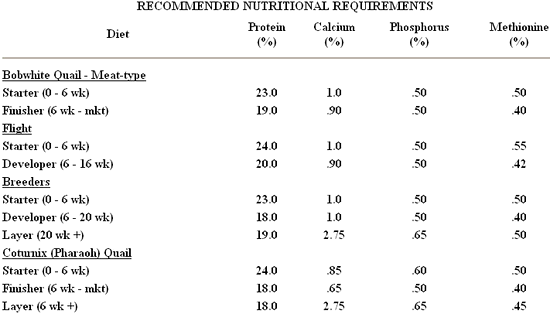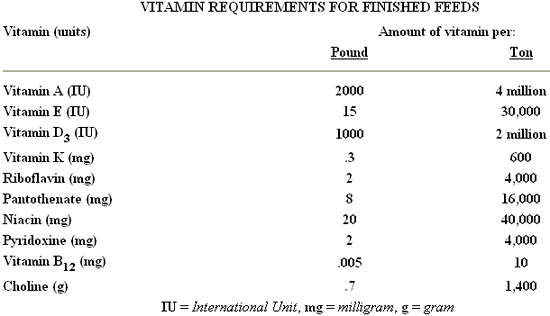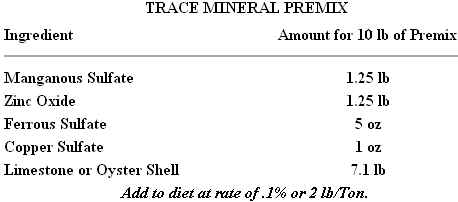



Feeding Quail
By Dr. Tom W. Smith, Jr., Emeritus Professor of Poultry Science, Mississippi State University - When incubating any bird egg it is important to control the same factors of temperature, humidity, ventilation, and egg turning. The chart shown below lists the major incubation factors and the values of each that produces the best incubation conditions for the species of birds shown.Feeding Quail - By Dr. Tom W. Smith, Jr., Emeritus Professor of Poultry Science, Mississippi State University - When incubating any bird egg it is important to control the same factors of temperature, humidity, ventilation, and egg turning. The chart shown below lists the major incubation factors and the values of each that produces the best incubation conditions for the species of birds shown.
The following topics are discussed in this information sheet:
- Feeding Programs
- Vitamins
- Minerals
- Medicated Feeds
- Dietary Formulations
- Water
- Nutritional Assistance
All poultry and game bird feeds are referred to as "complete" feeds. They are designed to contain all the protein, energy, vitamins, minerals, and other nutrients necessary for proper bird growth, egg production and health. Feeding other ingredients, either mixed with the feed or fed separately, upsets the balance of nutrients in the complete feed. Feeding additional grains or supplements is discouraged.
Young game birds kept for meat production or sport hunting are fed differently than birds saved for egg production or breeding. Meat-type Bobwhite quail have larger bodies and gain weight quicker than birds grown for "flight" purposes. Diets must contain nutrient levels that meet the dietary needs of the birds being produced. Meat-type birds fed as flight birds are more expensive to produce and use more feed; they are larger than necessary and not considered as good fliers. In contrast, smaller strains of Bobwhite quail are usually considered as good flight birds but not recommended as good meat producers. They do not convert feed to meat as well and produce less desirable carcasses when slaughtered.
Feeding Programs
Feed quail chicks a "starter" diet soon after hatching. Continue feeding the starter until birds are six or eight weeks old. The starter diet has the highest level of protein a bird receives during its lifetime. As the chicks age, their requirements for most nutrients decline, including dietary protein. But they need more energy.
After the chicks reach six or eight weeks old, feed meat-type birds a "finisher" diet, or feed flight birds and those saved for egg production a "developer" diet. Feed meat birds a finisher diet until slaughter. Feed flight birds and immature breeders the developer diet until you sell them or until they are about 20 weeks old. A few weeks before you expect egg production, offer breeders a "layer" diet until they complete their egg production period.
Another species of game birds used for meat or egg production are coturnix or pharaoh quail. They are seldom raised for hunting. These birds mature at an earlier age than bobwhite quail and may begin laying eggs at six to eight weeks of age. Coturnix quail grown for meat are provided starter and finisher diets, whereas laying/breeder birds are fed starter and breeder diets.
The minimum dietary requirements for protein, calcium, phosphorus and methionine for game bird feeds are shown below. It is important to provide the correct diet to the birds if you want the desired results. Remember, birds saved for egg production are fed developer diets, not finisher diets. Mature laying/breeder birds are fed only laying diets. Otherwise, you will see reduced egg production and more thin-shelled eggs.

Vitamins
Vitamins are always added to feeds in amounts that meet minimum dietary requirements. This ensures that birds receive plenty of vitamins for proper health and performance. Higher levels are not usually harmful, but excessive vitamin supplementation is unnecessary and expensive. Minimum vitamin requirements for various ages of birds are shown in below.
When adding vitamins to the diet as a premix, be sure to use enough premix to supply minimum levels of all vitamins. You may have to add extra amounts of some vitamins to achieve minimum levels for other vitamins. This may increase the cost of the complete feed but is better than creating vitamin deficiencies. In periods of stress caused by disease, shipping or sudden changes in the environment it is recommended that additional vitamins and electrolytes be provided in the drinking water until the stressing condition is corrected.

Minerals
Like vitamins, adequate levels of minerals must be provided to all birds. Minerals in breeder feeds are especially important. Laying quail require higher levels of minerals for egg shell formation. Chicks require high levels of minerals for proper bone formation and development. Breeder feeds are fed only to laying birds. If a breeder feed is fed to chicks, reduced growth and unnecessary stress results.
Although not always required for survival, a trace mineral premix added to diets will give better performance. Trace minerals are the minerals required at very low levels for good growth and production. Most feed ingredients contain these minerals but sometimes not enough of them. Many minerals are included in commercial vitamin premixes. An excellent trace mineral premix is shown below. The premix provides enough trace minerals when added at the rate of two pounds per ton of feed.

Medicated Feeds
Game bird feeds are available with several types of medications for preventing or treating diseases. The two most common medications added to feeds are coccidiostats and antibiotics. Coccidiosis is a parasitic disease of the digestive tract caused by protozoan organisms called coccidia. It is difficult to control by sanitation practices alone. The best prevention is continuous use of a drug or coccidiostat that reduces coccidia populations. The coccidiostat is usually added to the feed at low levels and fed continuously. Some coccidiostats are given at elevated levels for treating the disease when symptoms appear. Consult a nutritionist or pathologist before increasing the drug level, since some coccidiostats are toxic at elevated levels.
Growing birds are fed a ration containing a coccidiostat from hatch until the last week before slaughter. An unmedicated diet if fed during the last week to assure that no drug residues remain in the tissues of the birds. The feeding of unmedicated diets before slaughter is recommended when using any dietary drug, regardless of whether the restriction is required or not.
As birds mature, they develop a resistance to the coccidia organisms if you control exposure. Birds grown for breeder replacements are fed a coccidiostat until about 16 weeks of age. The medicated feed is then replaced with a feed not containing a coccidiostat. Spotty outbreaks of the disease can be controlled by including a coccidiostat in the water. Two coccidiostats with Food and Drug Administration (FDA) approval for use in quail feeds are monensin sodium (Coban) and amprolium.
Antibiotics are also be added to some feeds to improve performance and maintain healthy birds. When are added at low (prophylactic) levels, antibiotics prevent minor diseases and produce faster, more efficient growth. Higher (therapeutic) levels for treating disease outbreaks are usually given in water or injected into the bird. Examples of FDA approved antibiotics for quail diets are bacitracin and penicillin.
Bacitracin (50-200 grams per ton) or penicillin (20-50 grams per ton) is permitted in game bird diets preventatives against ulcerative enteritis (quail disease). Higher levels are not recommended nor permitted by FDA. Treatment levels are best administered in the birds' drinking water. This works better because sick birds usually drink water but do not necessarily consume feed. Including bacitracin in diets of all game birds is recommended to maintain healthy, productive birds.
When using any drug, carefully follow all label warnings and instructions. Always comply with all instructions that require a medication withdrawal period before slaughter or saving eggs for human consumption.
Diet Formulations
Several diets are included below that provide adequate levels of all nutrients for the type of birds cited. All ingredients must be used without substitution or alteration of quantities. Deviation from the recommended diets alters the levels of all nutrients and can create undesired problems. Always consult with a poultry nutritionist or your county agent before making dietary changes.
Most commercially prepared game bird feeds are fed in "crumble" form. These small feed aggregates are formed by partial regrinding or crumbling pellet made from the "mash" feed. Frequently the crumbles of starter feeds are too large for newly hatched quail to eat. Additional grinding is necessary to produce particles of the desired size. Crumbles are not necessary for good production although they have several desirable characteristics. Mash diets made from the dietary formulations shown below produce excellent performance. The assortment of ingredients used has intentionally been kept to a minimum. Many additional ingredients can be used, but ingredient substitutions require reformulation to adjust for nutritional variations in feedstuffs.
Attention to high quality ingredients is essential when making bird feeds. Before making the diets, make sure all ingredients are available. Poor quality ingredients may be tolerated in diets of some types of farm animals but not quail. If you use poor quality feedstuffs in quail diets, you will experience production problems. Never use a feed ingredient unless it is of highest quality.
Often high-quality commercial quail feeds are not available and substitutes are needed. You can substitute comparable turkey feeds for quail feeds without hurting performance. In most cases, chicken diets can be fed to growing bobwhite quail that are raised for slaughter. Check with a qualified nutritionist before making dietary substitutions.
If production problems occur that are "feed related", first get a sample of the feed. A one-quart sample of the feed is usually adequate. Contact an Extension Poultry Specialist for help in solving the problem. Submit a one- to two-cup portion of the feed to a laboratory for analysis of nutritional characteristics. Store the remaining sample for future reference.
If problems are unusually severe, temporary replacement of the suspect feed may be necessary until the cause is determined. Only use a suitable diet from another feed manufacturer, and preferably, from a different feed dealer. Purchasing additional feed from the same dealer and manufacturer may extend your problems because the new feed may have the same problem-causing characteristics. After determining the cause of the problem, if it is not feed related, you can resume using the original dealer's feed.

Water
Many producers overlook the importance of providing clean, fresh water to their flocks. Water, though not considered a nutrient by many producers, is the most important nutrient for animals. Like all farm animals, quail need clean water at all times. Drinking water must not get too hot or cold, or the birds may refuse to drink.
Clean the water troughs and replace with fresh water at least once daily. Keep water and feed troughs clean of droppings, litter, soil and other contaminants.
Position feed troughs to keep them clean and dry. Empty feed troughs at least two or three times weekly (daily if necessary) and refill with dry, fresh feed. Do not wash feed troughs unless they are excessively contaminated with wastes or unless the feed gets wet. Do not let the feed get moldy. Moldy feeds can kill quail.
Nutritional Assistance
If you need assistance with any problem related to quail production, contact your county agent or the Extension Poultry Specialists at Mississippi State University.
Source: Mississippi State University Extension Service - May 2004









